Breaking Silos: How Advanced OKR Cross-Functional Performance Drives Unprecedented Growth
What if we could help you accelerate your time-to-market by 60%? For companies that master cross-functional OKR alignment, this isn’t a hypothetical—it’s a reality. In today’s hyper-competitive landscape, organizational silos are silent killers of innovation and speed. OKRs bring alignment and focus to different teams and different functions, helping organizations in achieving their goals and driving collective success.
They create friction, miscommunication, and redundant work, leaving even the most brilliant strategies to wither on the vine. While most leaders recognize the problem, few understand how we can dismantle these barriers effectively without disrupting operations.
This is where we can shift to a sophisticated approach to Objectives and Key Results (OKRs) that becomes a game-changer. By moving together from a traditional, top-down goal-setting model to a dynamic, cross-functional framework, organizations can unlock unprecedented levels of alignment and execution. The biggest advantages of this approach include improved communication, greater transparency, and enhanced collaboration across different teams and functions.
This isn’t just about setting better goals; it’s an opportunity to empower your teams to rewire your company’s operational DNA together, fostering genuine collaboration and a shared sense of purpose. Implementing OKRs creates a more inclusive and collaborative culture that supports innovation and teamwork.
In this article, we’ll explore how advanced OKR cross-functional performance is not just a methodology, but a strategic imperative for any organization serious about winning in 2025 and beyond. Many organizations have found OKRs to be essential for breaking down silos and driving cross-functional success.
The Hidden Cost of Organizational Silos
For many leaders, the struggle against organizational silos can feel like a constant, uphill battle. Organizational silos are more than just an inconvenience; they are a significant drain on resources, morale, and market momentum. When teams operate in isolation, the ripple effects are felt across the entire business. A 2024 report revealed that poor leadership, a key driver of siloed behavior, remains the top barrier to successful OKR implementation, cited by 55% of organizations. This leadership gap perpetuates a culture of fragmented accountability, where no one owns the end-to-end customer journey.
When departments lack common objectives, misalignment and inefficiency increase, making it difficult for teams to collaborate effectively with other departments.
The financial and operational consequences are staggering. Without a unified, cross-functional approach, companies experience slower decision-making, duplicated efforts, and a disengaged workforce. In fact, research shows that only 14% of employees feel inspired to improve after traditional performance reviews, a system often reinforced by siloed management. This lack of inspiration translates into a tangible loss of productivity and innovation, directly impacting the bottom line.
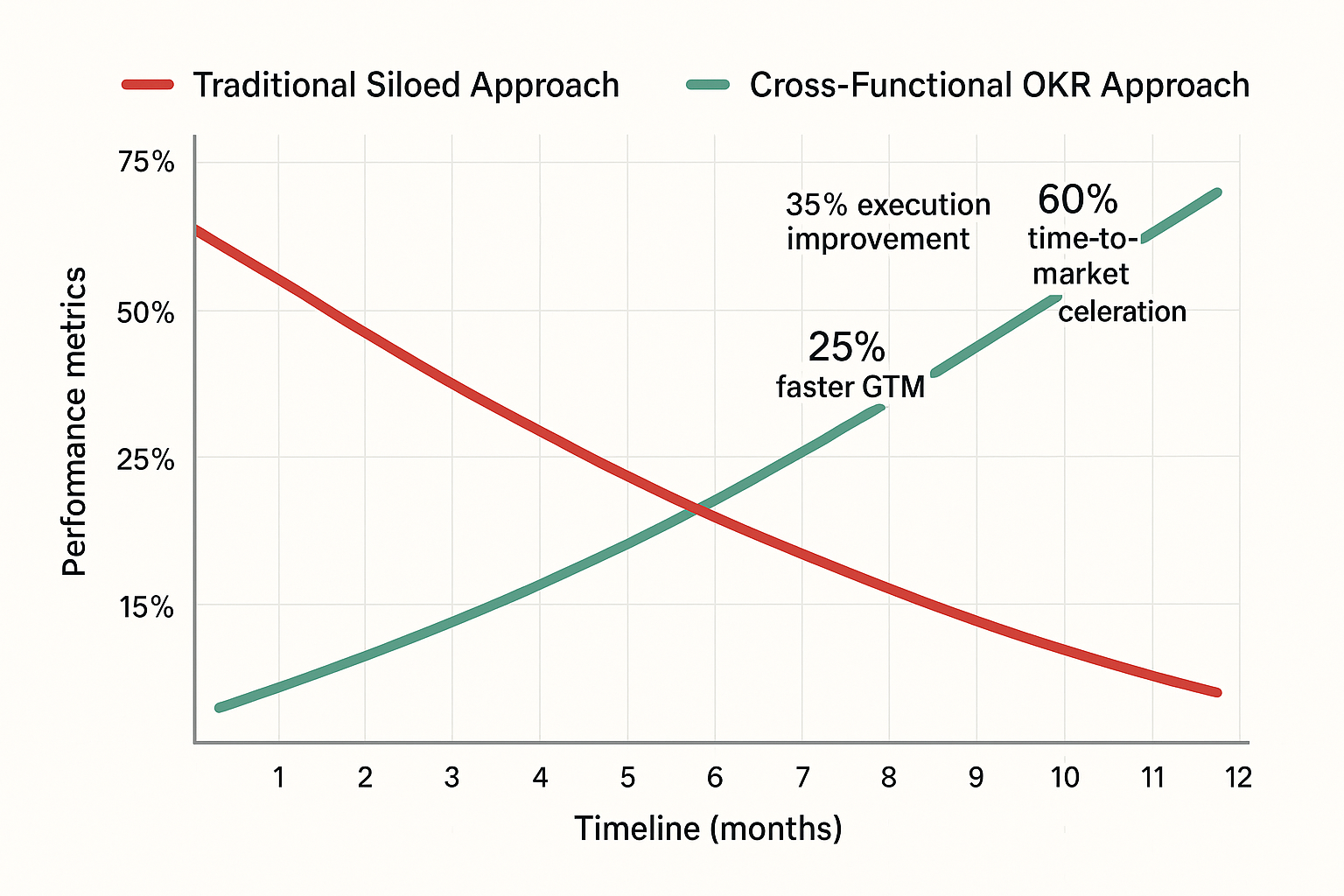
Even market leaders are not immune. Before its cultural transformation, Microsoft faced significant challenges with internal teams competing against each other, hindering its ability to innovate and respond to market shifts. The absence of a shared objective between different departments made collaboration difficult and reinforced silos.
The lack of a common purpose and shared goals created a complex web of dependencies that slowed down execution. It was only by adopting a more collaborative, cross-functional model, underpinned by a transparent goal-setting framework, that the company was able to break down these barriers and reignite its growth engine.
The Cross-Functional OKR Revolution
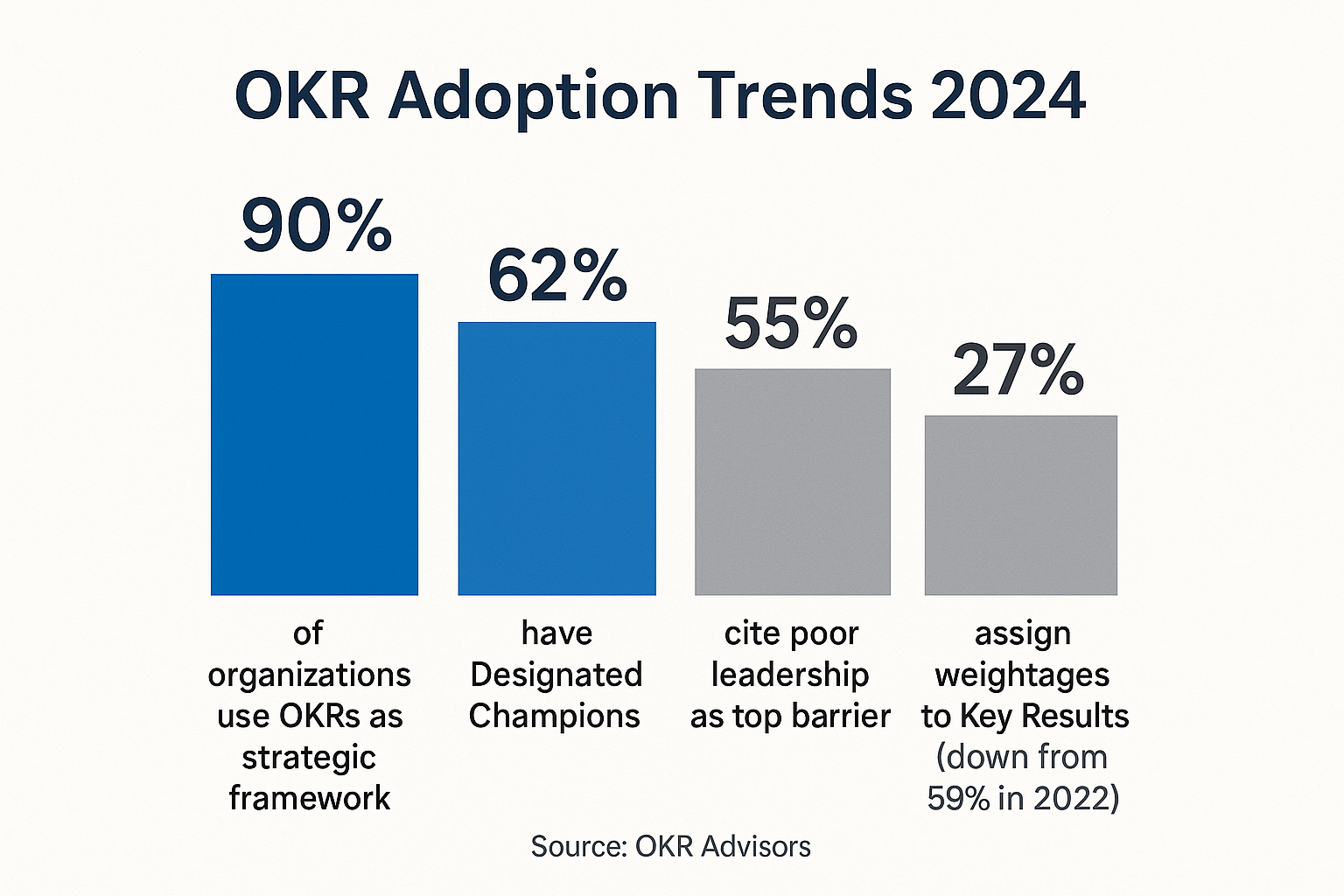
The shift to a cross-functional OKR framework is not just a trend; it’s a revolution in how modern organizations operate. With a 90% adoption rate in 2024, OKRs have become the definitive tool for translating strategy into measurable outcomes. But their true power is unlocked when we use them together to bridge departmental divides and unite teams around a common mission. This is where the magic of cross-functional alignment happens.
Take Netflix, a company renowned for its culture of innovation. Its success is built on a foundation of ambitious, transparent OKRs that cascade throughout the organization. By setting audacious goals and empowering small, autonomous teams to determine the best path to achieve them, Netflix fosters a culture of ownership and accountability.
Shared OKRs help align different teams around common objectives, ensuring everyone is working toward the same outcomes and improving communication across departments. This approach ensures that every team, from content acquisition to engineering, is aligned on the key results that matter most to the business.
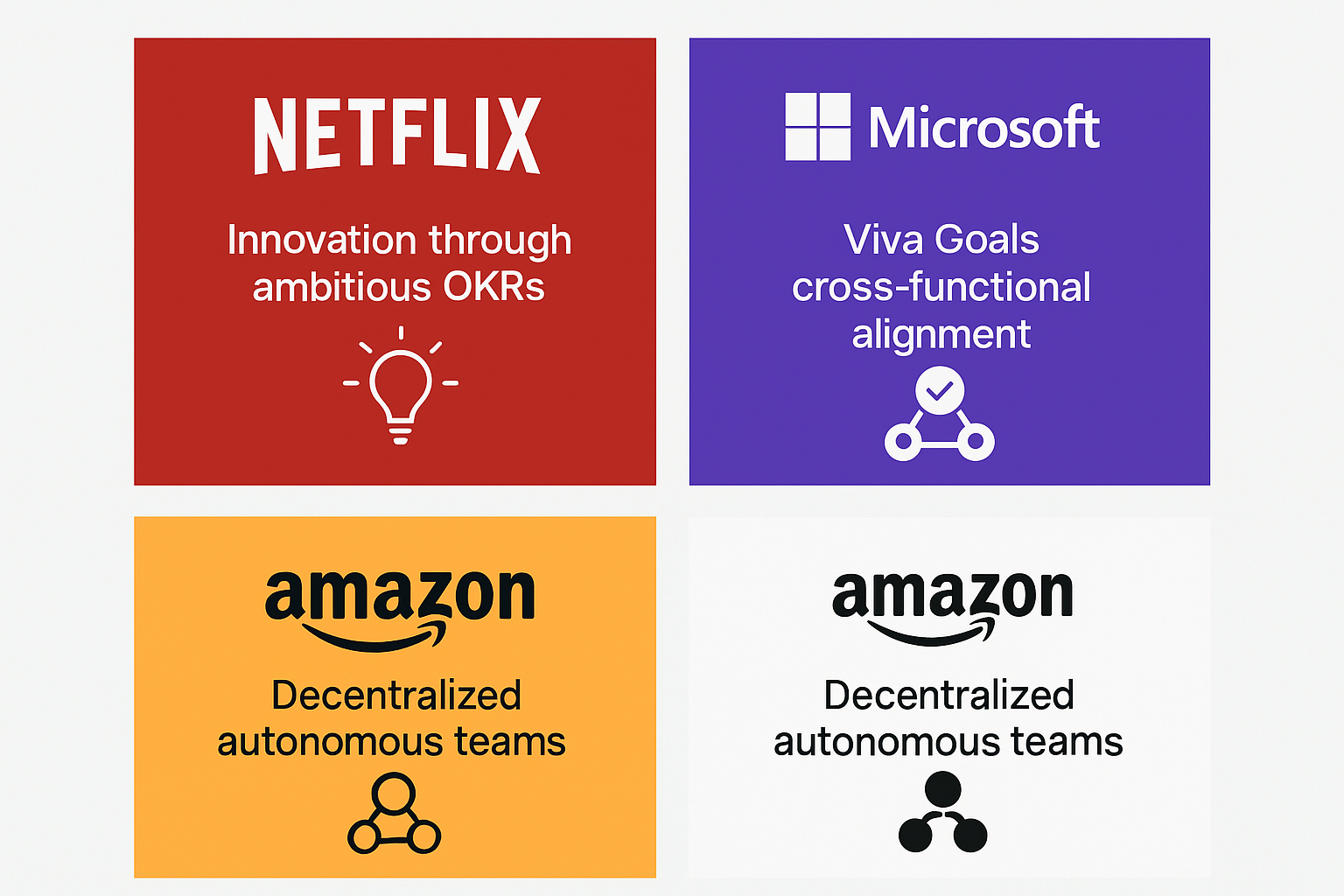
When discussing key results, it’s crucial to set specific key results that are detailed and measurable. These specific key results make it possible to track progress effectively and ensure alignment across teams, helping everyone stay focused on the overarching goals.
Microsoft offers another compelling example. With its Viva Goals platform, the company has embedded OKR alignment into its operational fabric. By creating a single source of truth for goals and progress, Microsoft has enabled seamless collaboration across its vast and complex organization. The platform ensures alignment by providing visibility into shared OKRs and progress, making it easier for teams to understand how their work fits into the bigger picture.
Their framework, which combines top-down strategic direction with bottom-up innovation, empowers teams to see how their work directly contributes to the company’s most critical priorities. This level of transparency is essential for breaking down silos and fostering a culture of shared success.
The Hyperdrive Agile Blueprint: An Advanced Implementation Framework
Transitioning to a cross-functional OKR model requires more than just adopting a new tool; it demands a new way of thinking and working together. At Hyperdrive Agile, we’ve developed a proven implementation framework that guides organizations through this transformation journey. Our goal is to empower your organization with the skills and confidence to drive this transformation from within, building a sustainable capability for cross-functional excellence, not just a one-time fix.
The 4-Phase Implementation Timeline
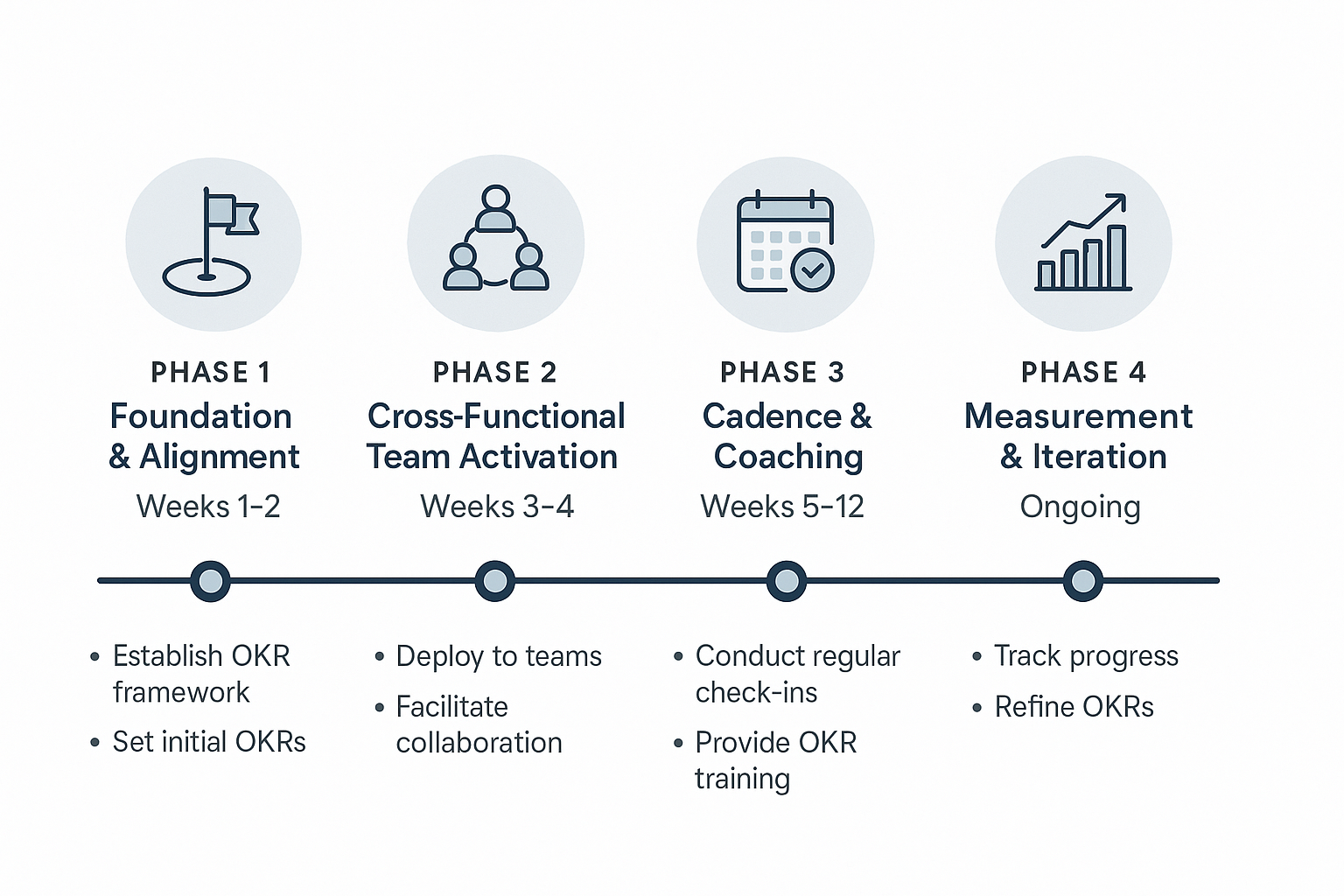
- Phase 1: Foundation & Alignment (Weeks 1-2): We start by working together with your senior leadership to define a handful of high-level, annual OKRs that are directly tied to your company’s strategic priorities. This ensures that your entire organization is rowing in the same direction from day one.
- Phase 2: Cross-Functional Team Activation (Weeks 3-4): Together, we identify the key value streams in your organization and assemble cross-functional teams around them. These teams are empowered to create their own quarterly OKRs that directly support the company-level objectives. This bottom-up approach, championed by companies like Amazon and LinkedIn, fosters a sense of ownership and accountability that your teams will embrace.
- Phase 3: Cadence & Coaching (Weeks 5-12): We establish a regular cadence of check-ins and progress reviews together, moving away from the outdated annual performance review cycle. Our expert coaches work with your teams to navigate roadblocks, celebrate wins, and ensure that everyone stays focused on the most impactful work. This is where the real cultural transformation begins to take hold within your organization.
- Phase 4: Measurement & Iteration (Ongoing): We help you define the key metrics that will measure the success of your cross-functional initiatives. This includes not only financial results but also leading indicators like time-to-market, employee engagement, and customer satisfaction. This data-driven approach allows for continuous improvement and ensures that your OKR framework evolves with your business.
Common Pitfalls and How to Avoid Them
-
Setting too many OKRs: We recommend working together to focus on no more than 3-5 objectives per team, with 3-5 key results for each. This forces ruthless prioritization and ensures that everyone is focused on what truly matters to your success.
-
Cascading goals too rigidly: OKRs should be a tool for alignment, not a rigid hierarchy. We encourage your teams to embrace a mix of top-down and bottom-up goal setting to foster innovation and agility.
-
Forgetting the “why”: Every OKR should be tied to a clear business outcome. We help you articulate the “why” behind each objective to inspire and motivate your teams toward shared success.
Measuring Cross-Functional Success: Beyond the Balance Sheet
How do you know if your cross-functional OKR initiative is truly working? While financial results are the ultimate lagging indicator, we believe a more holistic approach to measurement is needed to gauge the true impact of this transformation. At Hyperdrive Agile, we help our clients develop a balanced scorecard that captures both quantitative and qualitative measures of success.
Practical ROI Calculation Example
Let’s say a new product launch, which typically takes 12 months, is now completed in 8 months due to improved cross-functional collaboration. If the product generates $1 million in monthly revenue, the accelerated time-to-market has resulted in an additional $4 million in revenue. This is a simple yet powerful way to quantify the financial impact of breaking down silos together.
Key Performance Indicators for Cross-Functional Alignment
- Time-to-Market: As highlighted earlier, companies with strong cross-functional alignment can achieve up to a 60% faster time-to-market. This is a critical metric for any organization looking to outpace the competition.
- Employee Engagement & Retention: A 2025 Gallup study found that highly engaged teams are 21% more profitable. By giving your employees a clear line of sight into how their work contributes to the bigger picture, you can significantly boost morale and reduce turnover.
- Innovation Rate: Track the number of new ideas, features, or products that are generated and launched by your cross-functional teams. This is a leading indicator of a healthy, innovative culture that your organization can build together.
- Customer Satisfaction (CSAT) & Net Promoter Score (NPS): When your teams are aligned around the customer journey, the customer experience improves. Monitor these metrics closely to see the impact of your cross-functional efforts on the people who matter most—your customers.
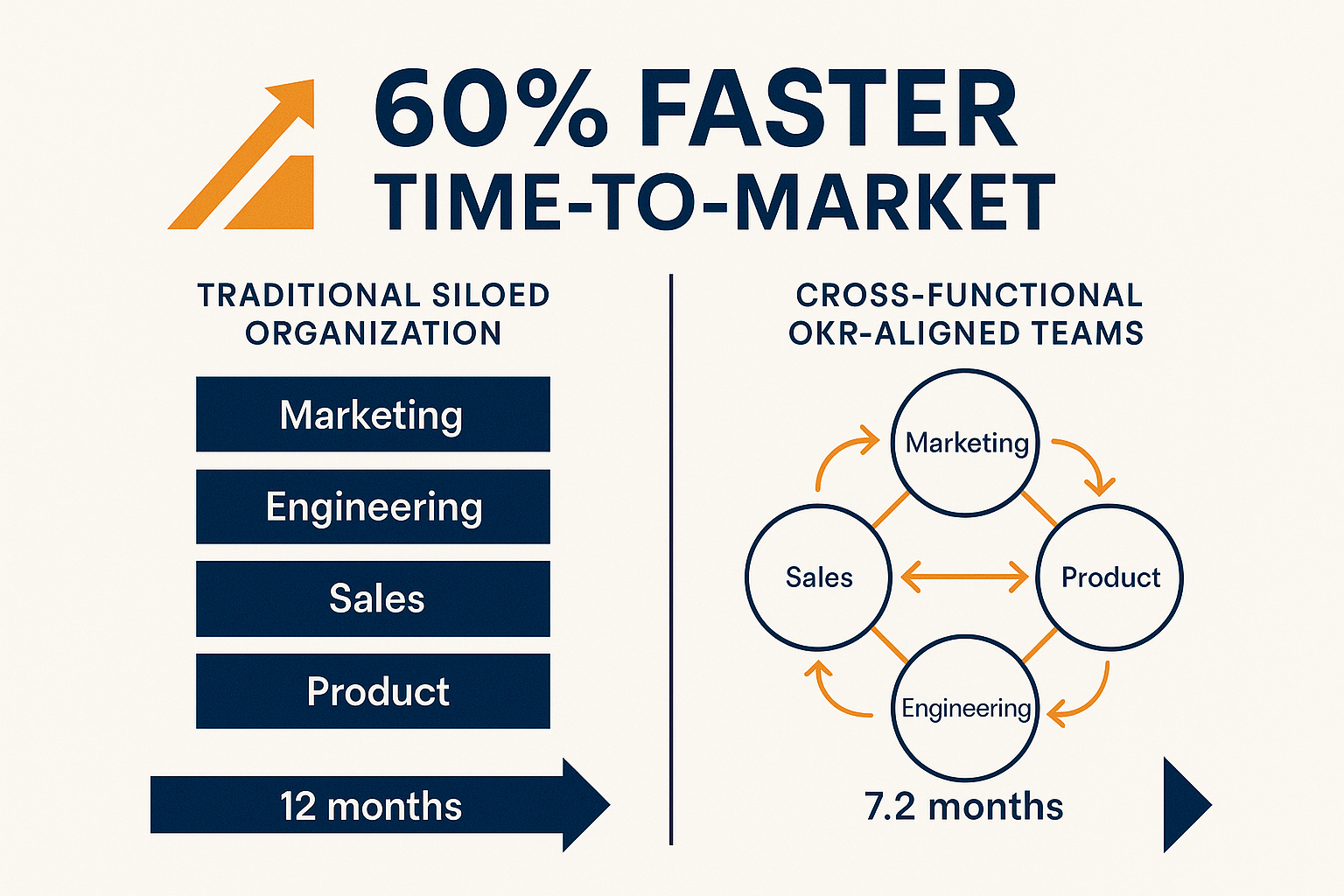
Getting Started: Your Journey to Cross-Functional Excellence
Embarking on a cross-functional OKR transformation can feel daunting, but it doesn’t have to be. The journey begins with a single, decisive step: a commitment from leadership to break down the barriers that are holding your organization back. From there, it’s about taking a structured, iterative approach together to building a culture of collaboration and shared accountability.
At Hyperdrive Agile, we partner with organizations to make this transition seamless and successful. Our team of expert coaches provides the guidance, tools, and support you need to navigate the complexities of this change and unlock the full potential of your teams. Whether you’re just starting your OKR journey or looking to take your existing framework to the next level, we can help empower your organization to achieve lasting transformation.
Ready to empower your teams and accelerate your business agility? Our tailored OKR training is designed to give you the tools and confidence to succeed. Visit our OKR training course page to explore our offerings and schedule a consultation with one of our experts.
Frequently Asked Questions (FAQ)
1. How long does it take to see results from a cross-functional OKR implementation?
While every organization is different, our clients typically start to see meaningful results within the first quarter when we work together. This includes improved alignment, increased transparency, and a noticeable uptick in team engagement. The full financial impact, such as accelerated time-to-market and revenue growth, usually becomes evident within 6-12 months as your teams build confidence and momentum.
2. How do you get buy-in from teams that are used to working in silos?
This is where strong leadership and clear communication are essential. We work with you to articulate a compelling vision for the future and to demonstrate how a cross-functional approach will benefit everyone, not just the bottom line. By starting with a few pilot teams and showcasing their success together, you can create a ripple effect of enthusiasm and adoption across your organization.
3. What is the biggest mistake to avoid when implementing cross-functional OKRs?
The most common pitfall is treating OKRs as a top-down directive. To be truly effective, OKRs must be a collaborative process that involves input from all levels of your organization. By empowering your teams to set their own goals in alignment with the company’s strategic priorities, you can foster a sense of ownership and accountability that is essential for long-term success.
Questions? We Can Help.
When you’re ready to move beyond piecemeal resources and take your Agile skills or transformation efforts to the next level, get personalized support from the world’s leaders in agility.